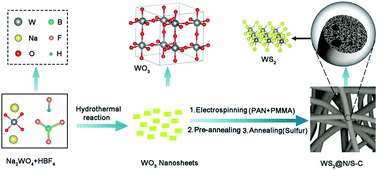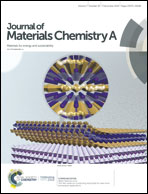Lotus rhizome-like S/N–C with embedded WS2 for superior sodium storage†
Abstract
Sodium-ion batteries (SIBs) hold great promise as power sources because of their low cost and decent electrochemical behavior. Nevertheless, the poor rate performance and long-term cycling capability of anode materials in SIBs still impede their practical application in smart grids and electric vehicles. Herein, we design a delicate method to embed WS2 nanosheets into lotus rhizome-like heteroatom-doped carbon nanofibers with abundant hierarchical tubes inside, forming WS2@sulfur and nitrogen-doped carbon nanofibers (WS2@S/N–C). The WS2@S/N–C nanofibers exhibit a large discharge capacity of 381 mA h g−1 at 100 mA g−1, excellent rate capacity of 108 mA h g−1 at 30 A g−1, and a superior capacity of 175 mA h g−1 at 5 A g−1 after 1000 cycles. The excellent performance of WS2@S/N–C is ascribed to the synergistic effects of WS2 nanosheets, contributing to larger interlayer spacing, and the stable lotus rhizome-like S/N–C nanofiber frameworks which alleviate the mechanical stress. Moreover, the WS2@S/N–C electrode shows obvious pseudocapacitive properties at 1 mV s−1 with a capacitive contribution of 86.5%. In addition, density functional theory calculations further indicate that the WS2@S/N–C electrode is very favorable for Na storage. This novel synthetic strategy is a promising method for synthesizing other electrode materials for rechargeable batteries in the future.



 Please wait while we load your content...
Please wait while we load your content...